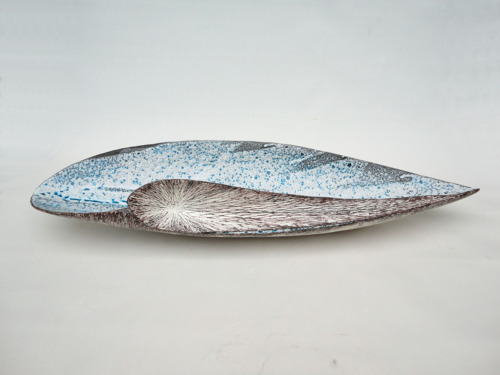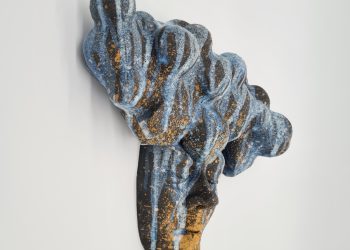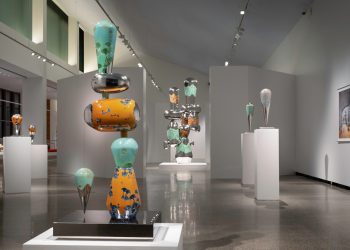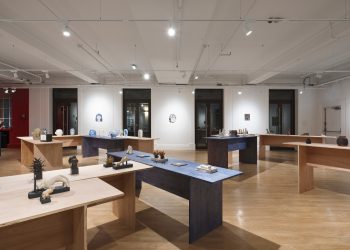
What was the starting point for your investigation with ceramics? Do you remember your early works?
When I was a student of Theology at the Doshisha University, I also belonged to the ceramic club. I was just absorbed to make something with clay in the club’s room. I worked for some textile company for two years after the graduation, and I entered Kyoto Saga Art College because I wanted to learn more throwing techniques. I remember the pieces I made in the college very well. The pieces I’ve made in my freshman year are the origins of my current series.
Your works may be simple, but the details, the lines and curves of your works are very sinuous. Tell us about how do you construct your pieces.
After creating the vessel or sculpture’s shape with coil techniques, the slip is applied to the surface. And then I groove the surface with needles one by one and in the end I rub iron into those grooves.
The important theme of my pieces is the shell – egg shells, shells of fruits or seashells because they are deeply related to the normal circles of life. The cobalt blue in the pieces represent the ocean, which is the origin of life on Earth. The wombs are considered to be the shell of human beings, so if I could express in my pieces the memories of leaving the wombs (leaving forever the protective and comfortable feeling), it would be wonderful.

KARA-10: Fu- a, 2010, Glazed clay, 7” x 26” x 4 1/2” (h) – View his works
We know that you work as an Associate Professor at Kyoto Saga University of Arts. What do you learn from this teaching experience?
From 2006 to September 2011, I had been working as a lecturer at Kyoto Saga Art College, but I am no longer a teacher there. Instead, I am working as a full-time ceramic artist.
I feel that being a teacher, and an artist is two different things. I learned that it was easy to teach the techniques, but it’s very difficult to teach how to express emotions through your pieces. I always advised my students that the valuable ideas might be in your pocket all the time.
How would you characterize the contemporary ceramic art scene in Japan?
I don’t like to make a border line between traditional ceramics and contemporary ceramics, because it is almost impossible to bundle the different perspectives over the definition of contemporary ceramics. Some artists believe that the contemporary should be the end of the extended track of tradition, so it shouldn’t be disturbed by the various opinions, but some artists are thinking that developing traditional skills is very important, but should always keep an eye on the stream of contemporary crafts and arts in the world. In other words, it looks like Sumo and Judo. I always want to be on the Judo side, but honestly speaking, I also emphasize with Sumo.
You have been a very active ceramic artist in the last years, with a lot of exhibitions going on. What are your future plans?
I am having several solo exhibitions in the near future and I have to create many pieces for a new resort hotel which will be opened in Japan in 2013. I also have a project in Singapore. I would like people around the world to see my pieces, and to imagine that through my pieces I am observing them back.
By Vasi Hirdo.
Published in Ceramics Now Magazine Issue 1.
Visit Keiko Gallery’s website.


















